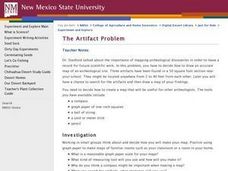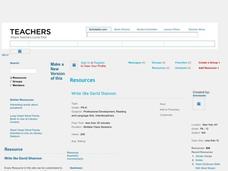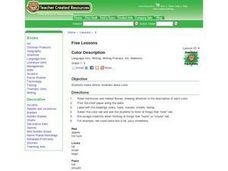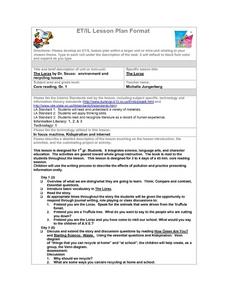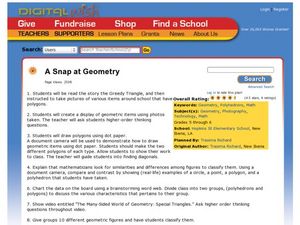Curated OER
Sing, America, Sing!
Students articulate their thoughts about citizenship in songs and poems. They write a songor a poem that describes what citizenship means to them. They plan a Citizenship Day during which students perform their songs and read their poems.
Curated OER
You've Got a Wocket Where?
Students identify rhyming word pairs, apply generalizations about the principle of onsets and "rimes," and create and classify multiple lists of words, both real and nonsense, based on given rhymes.
Curated OER
What's Your Opinion
Students complete a questionnaire, formulating opinions on issues that be addressed in the novel, Sing Down the Moon. They make predictions about events that might occur in the novel based on the group discussion.
Curated OER
The Artifact Problem
Students work in small groups and make a map of a familiar room. In this artifact lesson, students decide on a suitable scale for their maps, the tools they will use and how they will make it and decide on strategies they would use to...
Curated OER
The Water Cycle
Second graders use the program HyperStudio to draw and describe the water cycle. For this science and technology lesson, 2nd graders will first become familiar with the water cycle by exploring books and websites in the classroom. Next,...
Curated OER
Write Like David Shannon
Students research the author David Shannon. In this author study lesson, students discuss their favorite David Shannon book and write their own story using his style of writing. Students share their stories with their classmates.
Curated OER
The Nervous System
In this online interactive nervous system worksheet, students respond to 11 multiple choice and fill in the blank questions regarding the information included in the provided paragraphs.
Curated OER
Color Description
Students explore the use of description in literature and color. They read Hailstones and Halibut Bones and discuss the description of each color. Students what each color makes them think of and they create pictures for each color.
Curated OER
Assembling an Aircraft
Students practice reading directions from a task card to assemble a paper aircraft during their Moon, Mars and Beyond mission. They relate the activity to their mission work and recognize the importance of reading directions.
Curated OER
Scenic Attractions In Four Corners
Fourth graders find and list scenic attractions in SE Utah and the Four-Corners-region. They receive direct instruction and carry out activities in cooperative group settings. They combine their findings onto one large map at the end of...
Curated OER
Measuring Elevation
Students practice measuring elevation, one of the key coordinates used by astronomers. They describe how the elevation of an object is measured.
and combine compass directions and elevation to find celestial objects.
Curated OER
Is Soil Alive?
Third graders observe soil samples. They then form hypotheses as to whether or not soil is alive. Students read and discuss information about soil and components of soil. They state wheter or not they believe soil is alive and list...
Curated OER
Taoism
Pupils identify and interpret Taoism. Students gain knowledge of various eastern philosophies. Pupils transfer knowledge gained using the higher order thinking skills for analysis. Students identify the key figure in Taoism. Pupils...
Curated OER
Conexiones CD-Rom
Students complete an activity in Spanish. Writing in response to an email message, they write it in Spanish and print it out. They also read an article related to a specific chapter and research a topic of interest to them using the...
Curated OER
Environment and Recycling Issues
First graders read and understand the text found while conducting internet research. They recognize how literature records information and reflects the human experience. Students also compare and contrast answers to questions. Then...
Curated OER
Math & Science
Students examine a list of ideas to draw from for lesson planning. They complete a quiz on Math & Science and hand in notes they have taken as a resource for lesson planning. They develop developmental appropriate practice...
Curated OER
Scenic Attractions in Four Corners
Fourth graders find and list scenic attractions in SE Utah and the Four-Corners-region. They identify geographic characteristics of Utah and other states in the western region of the United States. They review cardinal directions and...
Curated OER
ESL: Horse Idioms
In this ESL "horse" idioms worksheet, students read sentences and determine the meaning of underlined idioms, 6 total. Page has links to additional resources.
Curated OER
Making Sense
Pupils use self-correcting strategies if they are stuck on a word in a simple sentence. In this reading lesson plan, students look at the covers of many books, and use the picture on the cover to help them figure out what the title might...
Curated OER
The Magic of Algebra: Original Lesson Plan
Students participate in a teacher led math "trick." The teacher "reads the mind of the students. The answer to the problem is always 4, and by following the directions, the teacher can guess that students are thinking of Denmark, and...
Curated OER
Living Thoreau As A Means Of Approaching Walden
Students investigate the essays and life of Thoreau in order to appreciate his point of view and understand his way of thinking. They participate in various activities and writing assignments to gain a similar perspective. Students write...
Curated OER
A Snap at Geometry
Students study geometric images and polyhedrons. In this geometry lesson, students complete several activities to learn about geometric shapes and classify polyhedrons from polygons. Students watch a video, complete a web-directed...
Curated OER
Geographics in Arkansas
Third graders discuss where Arkansas is located on the United States map. They use geographic tools to participate in activities.
Curated OER
Greater Than, Less Than, Equal to
First graders complete number comparison activities. In this number comparisons lesson, 1st graders review the names of comparison symbols and participate in visual comparison activities. Students practice using the gator and clam method...





